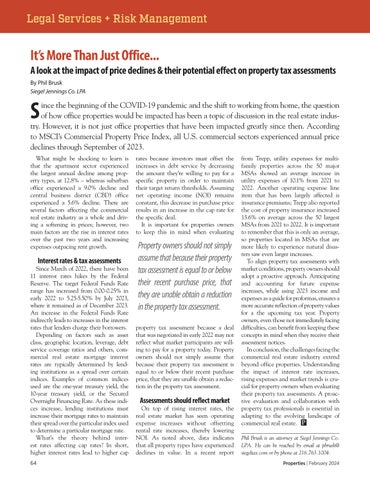Legal Services + Risk Management
It’s More Than Just Office... A look at the impact of price declines & their potential effect on property tax assessments By Phil Brusk Siegel Jennings Co. LPA
S
ince the beginning of the COVID-19 pandemic and the shift to working from home, the question of how office properties would be impacted has been a topic of discussion in the real estate industry. However, it is not just office properties that have been impacted greatly since then. According to MSCI’s Commercial Property Price Index, all U.S. commercial sectors experienced annual price declines through September of 2023. What might be shocking to learn is that the apartment sector experienced the largest annual decline among property types, at 12.8% – whereas suburban office experienced a 9.0% decline and central business district (CBD) office experienced a 5.6% decline. There are several factors affecting the commercial real estate industry as a whole and driving a softening in prices; however, two main factors are the rise in interest rates over the past two years and increasing expenses outpacing rent growth.
Interest rates & tax assessments
Since March of 2022, there have been 11 interest rates hikes by the Federal Reserve. The target Federal Funds Rate range has increased from 0.00-0.25% in early 2022 to 5.25-5.50% by July 2023, where it remained as of December 2023. An increase in the Federal Funds Rate indirectly leads to increases in the interest rates that lenders charge their borrowers. Depending on factors such as asset class, geographic location, leverage, debt service coverage ratios and others, commercial real estate mortgage interest rates are typically determined by lending institutions as a spread over certain indices. Examples of common indices used are the one-year treasury yield, the 10-year treasury yield, or the Secured Overnight Financing Rate. As these indices increase, lending institutions must increase their mortgage rates to maintain their spread over the particular index used to determine a particular mortgage rate. What’s the theory behind interest rates affecting cap rates? In short, higher interest rates lead to higher cap 64
rates because investors must offset the increases in debt service by decreasing the amount they’re willing to pay for a specific property in order to maintain their target return thresholds. Assuming net operating income (NOI) remains constant, this decrease in purchase price results in an increase in the cap rate for the specific deal. It is important for properties owners to keep this in mind when evaluating
Property owners should not simply assume that because their property tax assessment is equal to or below their recent purchase price, that they are unable obtain a reduction in the property tax assessment. property tax assessment because a deal that was negotiated in early 2022 may not reflect what market participants are willing to pay for a property today. Property owners should not simply assume that because their property tax assessment is equal to or below their recent purchase price, that they are unable obtain a reduction in the property tax assessment.
Assessments should reflect market
On top of rising interest rates, the real estate market has seen operating expense increases without offsetting rental rate increases, thereby lowering NOI. As noted above, data indicates that all property types have experienced declines in value. In a recent report
from Trepp, utility expenses for multifamily properties across the 50 major MSAs showed an average increase in utility expenses of 10.1% from 2021 to 2022. Another operating expense line item that has been largely affected is insurance premiums; Trepp also reported the cost of property insurance increased 13.6% on average across the 50 largest MSAs from 2021 to 2022. It is important to remember that this is only an average, so properties located in MSAs that are more likely to experience natural disasters saw even larger increases. To align property tax assessments with market conditions, property owners should adopt a proactive approach. Anticipating and accounting for future expense increases, while using 2023 income and expenses as a guide for proformas, ensures a more accurate reflection of property values for a the upcoming tax year. Property owners, even those not immediately facing difficulties, can benefit from keeping these concepts in mind when they receive their assessment notices. In conclusion, the challenges facing the commercial real estate industry extend beyond office properties. Understanding the impact of interest rate increases, rising expenses and market trends is crucial for property owners when evaluating their property tax assessments. A proactive evaluation and collaboration with property tax professionals is essential in adapting to the evolving landscape of commercial real estate. Phil Brusk is an attorney at Siegel Jennings Co. LPA. He can be reached by email at pbrusk@ siegeltax.com or by phone at 216.763.1004. Properties | February 2024
